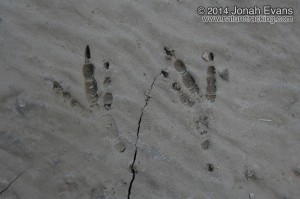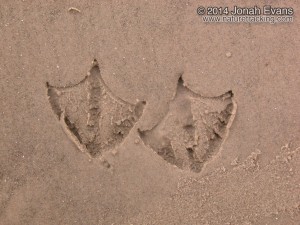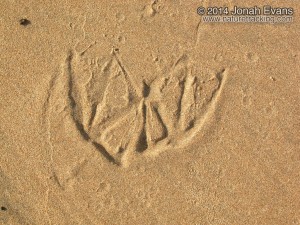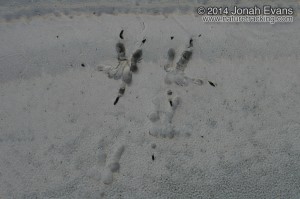Bird tracks and sign are commonly encountered yet often overlooked by beginner trackers. Bird footprints are actually simpler to identify than some other groups of animals because of their relatively simple foot structure. Bird tracks can easily be classified into 5 categories: Classic, Game Bird, Webbed, Totipalmate, and Zygodactyl. Learn about these categories by clicking on the “Identifying Bird Tracks” tab. Use the filter buttons below to view tracks of each type.
Bird Tracks Gallery Full Species List
- Acorn Woodpecker Tree
- American Coot Tracks
- Avocet Tracks
- Bald Eagle Tracks
- Band-tailed Pigeon Scat
- Barn Swallow Nest
- Black Vulture Tracks
- Black-bellied Plover Tracks
- Black-billed Magpie Tracks
- Brewer’s Blackbird Tracks
- Burrowing Owl
- Burrowing Owl Burrow
- Burrowing Owl Pellets
- Burrowing Owl Tracks
- California Quail Tracks
- Canada Goose Tracks
- Cattle Egret Tracks
- Cave Swallow Nests
- Chachalaca Tracks
- Cliff Swallow Nests
- Cliff Swallow Tracks
- Crested Caracara Tracks
- Crow Tracks
- Dove Scat
- Dove Tracks
- Downy Woodpecker Sign
- Duck Tracks
- Eurasian Collared Dove Tracks
- Flicker Scat
- Flicker Tracks
- Flicker Tracks and Tail Feathers
- Golden Eagle Tracks
- Goose Scat
- Grackle and Quail Tracks
- Grackle Tracks
- Great Blue Heron Track
- Great Blue Heron Tracks
- Great Egret Tracks
- Great-horned Owl Tracks
- Great-tailed Grackle Tracks
- Green Heron Track
- Ground Dove Tracks
- Grouse Droppings
- Grouse Tracks
- Harrier Tracks
- Hawk Tracks
- Heron and Killdeer Tracks
- Heron Scat
- Horned Lark Tracks
- House Sparrow Tracks
- Hummingbird Nest
- Jay Tracks
- Killdeer Tracks
- Ladder-backed Woodpecker Hole
- Lark Sparrow Tracks
- Laughing Gull Tracks
- Least Tern Eggs
- Long-billed Curlew Tracks
- Magpie Tracks
- Montezuma Quail Tracks
- Mourning Dove
- Mourning Dove Tracks
- Northern Flicker Tracks
- Owl Roost
- Owl Tracks
- Pelican Tracks
- Pileated Woodpecker Sign
- Poorwill Tracks
- Quail Scat
- Quail Tracks
- Raven Nest
- Raven Scat & Pellets
- Raven Tracks
- Rea Tracks
- Red-cockaded Woodpecker Sign
- Red-tailed Hawk Tracks
- Red-winged Blackbird Tracks
- Roadrunner Scat
- Roadrunner Tracks
- Robin Track
- Robin Tracks
- Rock Dove Tracks
- Royal Tern Tracks
- Ruffed Grouse Tracks
- Sage Grouse Tracks
- Sanderling Cough Pellets
- Sandhill Crane Tracks
- Sapsucker Holes
- Scaled Quail Tracks
- Screech Owl Tracks
- Scrub Jay Tracks
- Small Duck Tracks
- Snipe Probing
- Snipe Tracks
- Sparrow Feeding Sign
- Sparrow Foraging
- Spotted Sandpiper Tracks
- Swallow Digs
- Swallow Digs and Mud Dauber Digs
- Swallow Tracks
- Towhee Tracks
- Trumpeter Swan Tracks
- Turkey Eggs
- Turkey Scat
- Turkey Scratch
- Turkey Tracks
- Turkey Tracks Male Displaying
- Turkey Vulture Tracks
- Turkey Wing Drags
- Vulture Cough Pellets
- Vulture Tracks
- Willet Scat & Cough Pellets
- Wood Duck Tracks
- Woodpecker Sign
- Woodpecker Tracks
Bird tracks can easily be classified into 5 categories: Classic, Game Bird, Webbed, Totipalmate, and Zygodactyl. While there are technically more types of bird feet, this system is convenient for identifying tracks. Identifying bird tracks is actually much easier than many people think. Once the track is assigned a category, it can be quickly narrowed down by measuring the length and using the quick references in Bird Tracks and Sign by Mark Elbroch. Click on the “Resources” tab to read more about this and other books for identifying bird tracks.
Classic Tracks (also called anisodactyl) have 3 toes pointing forward and one long toe pointing backward. This is common in perching birds, doves, hawks, ravens, herons, egrets, and many others.
Game Bird Tracks are similar to classic tracks, except the toe in the back is much smaller or absent altogether. This group includes quail, turkey, plovers, sand pipers, cranes, and others.
Webbed Tracks are similar to game bird tracks, except the forward facing toes are webbed. Also, the outer toes in webbed tracks curve slightly inward. This group includes ducks, geese, gulls, terns, and more.
Totipalmate Tracks have webbing between all 4 toes. This group contains pelicans and cormorants and some other ocean dwelling species.
Zygodactyl Tracks have 2 toes pointing forward and 2 pointing backward. This includes roadrunners, cuckoo’s, woodpeckers, and owls.
The following images are the recent bird track observations from the North American Animal Tracks Database. This is an iNaturalist project where trackers share observations and help each other learn about animal tracks, all while contributing to scientific research.
The guides below are my absolute favorites for identifying bird tracks. If you decide to purchase any of these guides, using the links below to Amazon will help support future developments to this website.
Bird Tracks and Sign is the only guide solely dedicated to identifying bird tracks in North America. If you’re at all interested in bird track identification, this book is an absolute must. Bird track identification is actually much easier than many people think. This guide simply divides bird tracks into 5 categories. To identify a track, determine the category, measure the length, and then compare it with the quick reference tables on the front and back covers to determine species that overlap in size. While I highly recommend this book, I really wish it contained a section of life-sized drawings.
Animal Tracks and Scat of California is a regional guide, but many of the species are found throughout North America. This guide includes mammals, birds, and even some reptiles, amphibians, and invertebrates. It is a great general tracking guide (full disclaimer: I am a co-author of this guide) and is a great bet if you want a single guide that covers more than just mammals. This book also has some helpful sections not found in Bird Tracks and Sign including a quick reference to life sized bird tracks.
Bird Feathers is a wonderful example of how much more there is to tracking than footprints. This guide to bird feather identification is written by two excellent trackers: Dave Scott and Casey McFarland. Dave runs the Earth Native Wilderness School in Austin Texas and is a Track and Sign Specialist. Casey is a Track and Sign Evaluator with CyberTracker Conservation and is one of the best trackers in the country. In Bird Feathers, Dave and Casey painstakingly collected and photographed the feathers of 397 birds. They also explain how to “read” a feather to know the not just the part of wing it came from, but also the type of wing. I highly recommend this book for birders and trackers.
Wildlife of the Pacific Northwest is a regional guide written by my friend and excellent tracker David Moskowitz. While this book primarily focuses on the Northwest, a lot of information applies nationwide. This tracking guide includes mammals, birds, reptiles, amphibians, and invertebrates. It dedicates an entire 32 pages specifically to birds. The guide also contains excellent original artwork by Dave and some incredible photography.
Tracks & Signs of the Birds of Britain & Europe is the most comprehensive guide to bird tracks for Europe. It is currently out-of-print, but there are still lots of used copies floating around. Be sure to get the 2003 version if you can. There is also an eBook version that is available for download.














